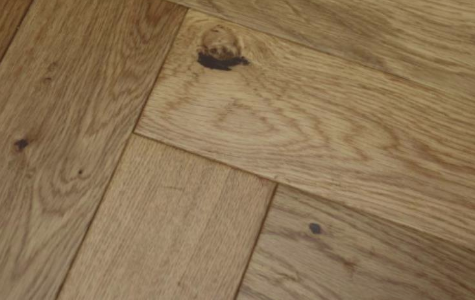Herringbone floors may have been the first parquet pattern developed in Europe, perhaps because it simply involved turning the wood planks at an angle, and it also echoed zig-zag brickwork that had decorated churches and other buildings for centuries.
In fact, back when people had dirt floors in their home, some homemakers would scatter sand on the floor and then sweep it into decorative patterns, including a chevron pattern. So it makes sense that it would have quickly become a popular option once wood floors became de rigueur. One of the earliest extant instances of wood herringbone is in the Francois I Gallery Fontainebleau in France. The floor was installed in 1539, during Francois I's reign, and was designed and produced by Italian craftsmen whom Francois had hired away from Italy. This corroborates descriptions from the era that refer to parquet as an Italian technique. In French, the herringbone pattern is known as batons rompus, which literally translates to broken sticks, and supposedly comes from a specific drumbeat from military history. More recently, the phrase not only refers to the pattern but also to something disorganized, like an excited conversation. There's a rhythm to life there's a rhythm to art watch the rhythm of man turn into art. Live your life on a masterpiece. When the best just comes standard.
Showing 1–21 of 28 results
-
Sale!

Brushed White Lacquered Herringbone Engineered Oak 14 x 3 x 110 x 660mm Wood Flooring (2064)
£85.00£62.50 Free Sample -
Sale!

Unfinished Solid Oak Herringbone Wood Flooring Oak 22 x 80 x 400
£75.00£62.50 Free Sample -
Sale!

Lacquered Click Herringbone Engineered Oak 14 x 3 x 150x 600 Wood Flooring
£75.00£62.50 Free Sample -
Sale!

Smoked Brushed Oiled Parquet Click Engineered Oak 14x 3x 150 x 600 Wood Flooring
£95.00£62.50 Free Sample -
Sale!

White Washed Lacquered Herringbone Engineered Oak 14mm x 3mm x 90mm x 450mm Wood Flooring(Prime Grade)
£75.00£62.50 Free Sample -
Sale!

Brushed White Lacquered Herringbone Engineered Oak 14 x 3 x 150 Wood Flooring
£75.00£62.50 Free Sample -
Sale!

Invisible Oiled Herringbone Engineered Oak 14x 3x 150x 600 Wood Flooring
£75.00£62.50 Free Sample -
Sale!

Solid Unfinished Parquet Herringbone Block Oak 16mm x 70mm
£65.00£62.50 Free Sample -
Sale!

UV Oiled Herringbone Engineered Oak 14 x 3 x 150 x 600 Wood Flooring
£75.00£62.50 Free Sample -
Sale!

Lacquered Herringbone Engineered Oak 14 x 3 x 90 x 450 Wood Flooring
£75.00£62.50 Free Sample -
Sale!

Lacquered Herringbone Engineered Oak 18 x 4 x 90x 400 Wood Flooring
£75.00£62.50 Free Sample -
Sale!

Parquet Herringbone Lacquered Oak 18mm x 4mm x 90mm x 400mm
£75.00£62.50 Free Sample -
Sale!

Slate Grey Click Herringbone Engineered Oak 14 x 3 x 150x 600 Wood Flooring
£75.00£62.50 Free Sample -
Sale!

Bracken Herringbone Engineered Oak 14x 3x 90x 400 Wood Flooring
£75.00£62.50 Free Sample -
Sale!

Classic Brushed Oiled Herringbone Engineered Oak 18 x 4 x 90 x 400 Wood Flooring
£75.00£62.50 Free Sample -
Sale!

Brushed Lacquered Click Herringbone Engineered Oak 14 x 3 x 150x 600 Wood Flooring
£75.00£62.50 Free Sample -
Sale!

Herringbone Brushed Coffee Engineered Oak 15 x 3 x 120 x600Wood Flooring (Prime Grade)
£125.00£62.50 Free Sample -
Sale!

Herringbone Grey Washed Lacquered Engineered Oak 15 x 3 x 120 x 600 Wood Flooring
£75.00£62.50 Free Sample -
Sale!

Herringbone Brushed Caramel Engineered Oak 15x 3×120 x600 Wood Flooring (Prime Grade)
£75.00£62.50 Free Sample -
Sale!

Engineered Chevron Unfinished Oak 20mm x6mmx120mm/15mm x4mm x90mm/14mm x3mm x130mm(Oiled )
£95.00£70.83 Free Sample -
Sale!

Herringbone Raw Saw Mark Engineered Oak 15 x4 x100 x600 Wood Flooring (Prime Grade)
£125.00£70.83 Free Sample























